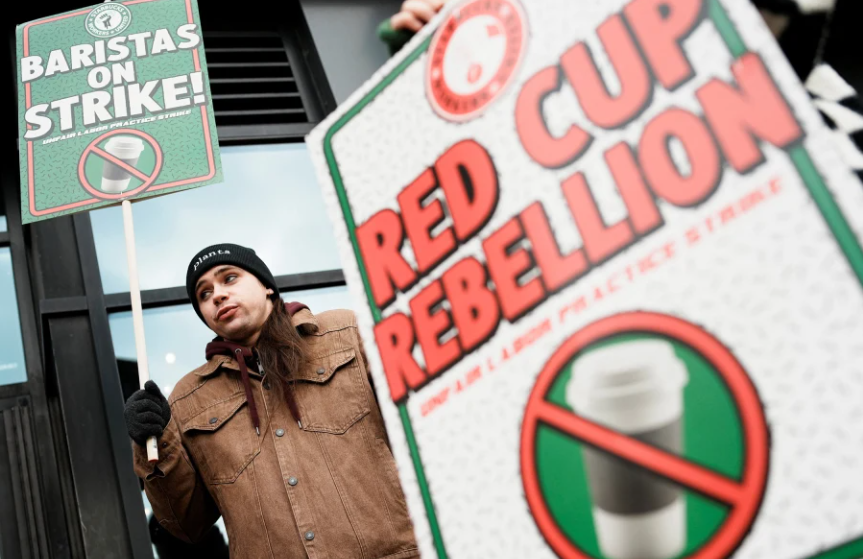More than 1,000 unionized Starbucks employees across the United States walked off the job Thursday, staging a coordinated strike at 65 stores to protest stalled contract negotiations and demand better pay and working conditions.
The timing was no accident. The strike coincides with Red Cup Day, one of Starbucks’ busiest promotional events of the year, when customers receive a free reusable holiday cup with the purchase of a festive drink. The union — Starbucks Workers United — said the goal was to disrupt operations and draw attention to the company’s resistance to finalizing a labor contract.
Stores in at least 45 U.S. cities joined the strike, including locations in New York, Philadelphia, Minneapolis, San Diego, St. Louis, Dallas, Columbus, and Starbucks’ home city of Seattle. Organizers said more stores could join in the coming days if negotiations remain deadlocked.
Workers Frustrated Over Stalled Negotiations
Union leaders say Starbucks has repeatedly delayed or avoided reaching a collective bargaining agreement since workers began organizing in 2021. The first store to unionize was in Buffalo, New York, marking a historic shift in the company’s labor relations.
In late 2023, Starbucks pledged to reach a deal by the end of 2024. However, after former CEO Laxman Narasimhan left the company last year, progress reportedly halted under new CEO Brian Niccol.
Employees say they are striking for higher pay, guaranteed hours, and fair scheduling. Many baristas complain they often don’t receive the 20 hours per week required to qualify for benefits. Workers also cite unfair labor practices, including the firing of union organizers and unilateral policy changes such as restricting restroom access to paying customers.
Starbucks Defends Its Pay and Benefits
Starbucks insists it already offers one of the best compensation packages in the retail industry, averaging $30 per hour when wages and benefits are combined. The company provides up to 18 weeks of paid family leave, as well as 100% tuition coverage for a four-year college degree.
In a letter to employees last week, Chief Partner Officer Sara Kelly said union representatives had “walked away from the bargaining table” earlier this year. She emphasized that Starbucks “remains ready to reach a reasonable deal” and pointed out that internal surveys show most employees are satisfied with their jobs.
The company noted that the majority of its 10,000 company-owned stores and 7,000 licensed locations remain open and operating normally.
A Small but Visible Strike
While only about 550 Starbucks stores nationwide are currently unionized, experts say the strike’s impact lies in its visibility, not its size.
“This kind of public action draws attention to workers’ concerns in a way that’s hard for consumers to ignore,” said Todd Vachon, a labor relations expert at Rutgers University. “Retail workers rely on public image and customer relationships — and that gives unions a powerful way to apply pressure.”
Starbucks has faced similar walkouts before. Workers also struck on Red Cup Day in 2022 and 2023, and last year a five-day pre-Christmas strike shut down 59 stores nationwide. Each time, Starbucks said the disruptions were minimal.
Company Sees Modest Sales Growth
Despite the labor tensions, Starbucks recently reported a 1% increase in same-store sales between July and September — the first gain in nearly two years. CEO Niccol has introduced new store designs, improved staffing for rush hours, and focused on boosting in-person orders after years of heavy mobile demand.
The company’s holiday drink rollout last week was a major success, with its limited-edition Bearista glass cup selling out within hours. Starbucks said demand exceeded expectations but has not confirmed whether the item will return before the holidays end.
